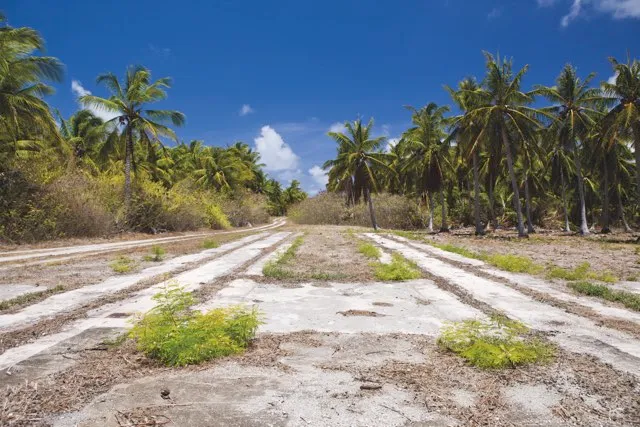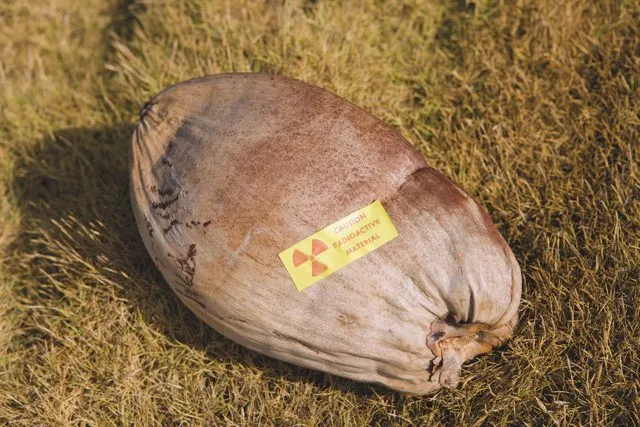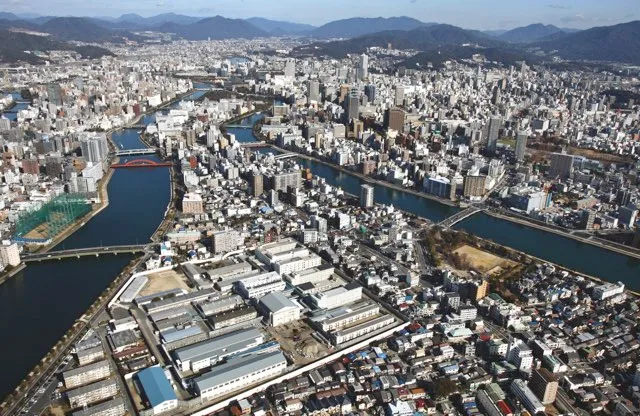In early 2018, the Doomsday Clock ticked forwards to two minutes to apocalypse – the closest it’s been since 1953 when the US and the Soviet Union tested hydrogen bombs.
The Bulletin Of The Atomic Scientists opted to move the clock forwards due to growing concerns about potential nuclear war, whether such events be borne of strife between the US and North Korea, Pakistan and India, or some other crisis point.
Read more:
- Could Chernobyl happen again without human error?
- How plants can survive space missions and Chernobyl
In the past, we have seen the immediate effects of radiation, through nuclear bombs or power station failures. By visiting radioactive sites like these, enterprising scientists can find out about the long-term impact of radiation on the environment, so we know what to expect in the event that someone pushes the big red button.
Going nuclear
One place that might offer some clues is Bikini Atoll, a ring-shaped coral reef located in the Marshall Islands. In 1946, the US evacuated Bikini’s residents, then spent 12 years testing its nuclear firepower by detonating 23 nuclear bombs there, including one that packed 1,000 times the power of the one that devastated Hiroshima and was the largest nuclear device that the US ever exploded. It’s a place, you might think, that’d be completely devoid of life to this day.
But in 2016, Steve Palumbi, professor of marine sciences at Stanford University in California, visited Bikini to document the marine life. He first got interested in Bikini while researching his book The Extreme Life Of The Sea. He learned that the age of organisms could be determined by measuring their artificial carbon-14 levels caused by hydrogen bomb tests in the middle of the last century. So when he was invited by the US television station PBS to do a documentary series called The Big Pacific, he told the producers that he wanted to go to Bikini Atoll.

Rather than finding it barren, he discovered a diverse array of species including corals, fish, sharks and crabs thriving in the atoll’s waters. Undoubtedly, the complete absence of humans for more than seven decades has helped create an undisturbed territory in which wildlife could flourish.
“When you started looking at the reports and hints, we were expecting to see some recovery – we just had no idea how extensive,” he says. And according to his team’s observations, the organisms appeared quite normal, with no obvious mutant characteristics. “There are a lot of strange things there – like coconuts the size and shape of zucchinis [courgettes] on the trees,” he says. “But can you really pin these things on radiation? It’s not all that clear.”

Ukraine provides another example of the surprising ways that life can recover after exposure to radiation. Early on 26 April 1986, reactor 4 of the Chernobyl nuclear power plant exploded, due to a fatal combination of engineering glitch and human error. Between the explosion and the subsequent fire, which raged for 10 days, the Chernobyl nuclear disaster spewed about 400 times more radioactive material into the atmosphere than what was released by the Hiroshima and Nagasaki bombs combined. Ultimately, officials evacuated some 330,000 people from the region and established a so-called Chernobyl Exclusion Zone that today covers about 4,200km2, graded by four levels of contamination.
“We don’t really know very much about what went on right after the disaster at Chernobyl, other than the fact that everything was wiped out for many miles – everything from trees, to mammals, to insects,” says Prof Timothy Mousseau, a biologist at the University of South Carolina.
Road to recovery
In the decades since, researchers have watched the region closely for signs of recovery. Prof Jim Smith, an environmental scientist at the University of Portsmouth, has worked with scientists from Belarus to monitor some of the mammals that live in the zone, such as wild boar, elk and wolves. Surprisingly, he says, populations seem to have bounced back, both in terms of abundance and diversity. As Smith explains, contamination within the zone is uneven: about 1 per cent of the region consists of areas like the infamous Red Forest, with its off-the-chart radiation levels, while much lower levels exist elsewhere. But even in the hotspots, he and his collaborators have seen no decrease in population numbers of big mammals (except wolves) compared to nearby radiation-free nature reserves.
So if wildlife has flourished in the decades after a nuclear event, does it suggest that these regions have rapidly recovered? Absolutely not, says Palumbi about Bikini. “It looks fine, but there’s an invisible menace there,” he explains. In the early 1970s, some people who had lived at Bikini Atoll before the bomb tests were told they could return, only to be re-evacuated a few years later due to lingering unsafe radiation levels. “If you do exactly what you’re not supposed to do and follow the signals [of the radiation counter] to where it gets stronger, you end up at the water well [a freshwater source],” he says.

A 2016 study that re-examined radiation levels at the Marshall Islands concluded that Bikini’s contamination is higher than previously thought, although at other islands it seems to have dissipated. Researchers concluded that figuring out whether the islands had become habitable would involve determining the radioactive dose from ingesting food farmed or caught there.
“Every day there were moments that told you something was very wrong about the place, like when the boat’s navigation system screamed we had run aground because it was using maps from 1935, and where we were anchored – in 49 metres of water – had been an island back then,” says Palumbi.
The story in Chernobyl is perhaps even more complicated. Mousseau points out that, for wildlife, the presence of humans is in some ways worse than large doses of radioactivity. This is because humans encroach on the habitats of many animals through settlement, hunting and agriculture. That’s why his team studies organisms like small rodents, insects, birds and trees. As these are less influenced by the presence or absence of humans, it gives the scientists more opportunity to home in on the effects of radioactive contaminants, he says.
Read more:
Mousseau and his colleagues do see problems on both the population and the individual level that they believe stem from elevated radiation levels. For example, they reported a heightened incidence of cataracts and generally smaller brains in birds and small mammals at Chernobyl. In radiation hotspots, 40 per cent of birds in some years were completely sterile, they found.
What’s more, while they observed wolves and some other animals thriving, unlike Smith’s group they reported a lower abundance of insects, birds and mammals in highly radioactive regions, as well as reduced rates of growth in pine trees. They found that leaf litter was thicker in areas with high levels of contamination, which suggests that numbers of decomposers – like bacteria and fungi – are reduced. These organisms carry out an essential role in breaking down organic matter to release its carbon and nitrogen. In fact, the Red Forest itself does not seem to be decaying properly, despite having died off following the explosion more than 30 years ago.
Hope for humans
How all this translates to human health is far from clear. The more complex an organism is – and humans are relatively complex – the more susceptible to radioactivity it is thought to be. But the main reason places like Bikini Atoll and Chernobyl are deemed too dangerous for us is not down to some physiological differences between humans and other animals, but because the threshold of risk is set much lower for us than for wildlife.
“It comes down to a political and sociological discussion – not a scientific one,” Smith says. He believes that the recent research suggests that in reality, the risk in much of the region around Chernobyl now is not very high. “Organisms are used to mutation, it’s part of life,” he says.
In truth, scientists know little about how chronic exposure to low-level radiation affects the body. One of the main planks for understanding the link between radiation exposure and cancer is the so-called Life Span Study, in which 94,000 survivors of the bombing of Hiroshima and Nagasaki, 27,000 unexposed individuals, and their children, have been monitored since 1950. But even there, the effects are less significant than most people think, Smith says. Mousseau, however, argues that endpoints other than cancer, like number of cataracts, head size or immune disorders, reveal a more nuanced picture.

But Palumbi thinks that data from Bikini Atoll could help us fill that knowledge gap. He plans to look at mutation rates in organisms such as corals, which live a long time, and coconut crabs, which regularly eat the most contaminated thing on the island – coconuts – to probe the effect of low-dose exposure on a genomic level. Mousseau, meanwhile, hopes to pursue in-depth genomic and other types of molecular studies in people from near Chernobyl.
Modern nukes
It’s hard to say how all these variables contribute to the picture of what might happen in the case of an exchange of nuclear bombs today. The biggest concern, experts agree, would be immediate. The most devastating impact of the bombs dropped on Hiroshima and Nagasaki was the blast and acute aftermath: estimates suggest some 135,000 and 70,000 people died, respectively, with half of the deaths occurring on the day of the blasts and the rest of the victims experiencing horrific effects over the weeks and months afterwards.
Experts caution that the impact would likely be exponentially larger for any bomb dropped today. “The bombs dropped on Nagasaki and Hiroshima were itsy-bitsy tiny atomic bombs compared to the bombs that we have now,” says Mousseau. Today’s bombs are about 1,000 times more powerful, and the reactions powering them will be more efficient.
Depending on how many bombs were dropped, and how big they were, nuclear fallout from the explosion would add further contamination in the days and weeks after an explosion. In 1983, the physicist Carl Sagan proposed the controversial notion that if a nuclear explosion tossed enough soot and dust into the air, it could absorb a significant amount of the Sun’s rays, causing a nuclear winter.
Using the same models that scientists use to predict the long-term effects of climate change, Prof Alan Robock, an environmental scientist at Rutgers University in New Jersey, has calculated that a regional nuclear war could lead to a massive drop in agricultural capacity, a reduction in temperature and precipitation, and an increase in UV irradiation caused by the destruction of the ozone layer. “Global warming would not be one of the things we’d ever worry about again,” says Mousseau. These are just models, of course, but could it happen? It’s best that we never find out.
- This article was first published in March 2018
Follow Science Focus onTwitter,Facebook, Instagramand Flipboard
